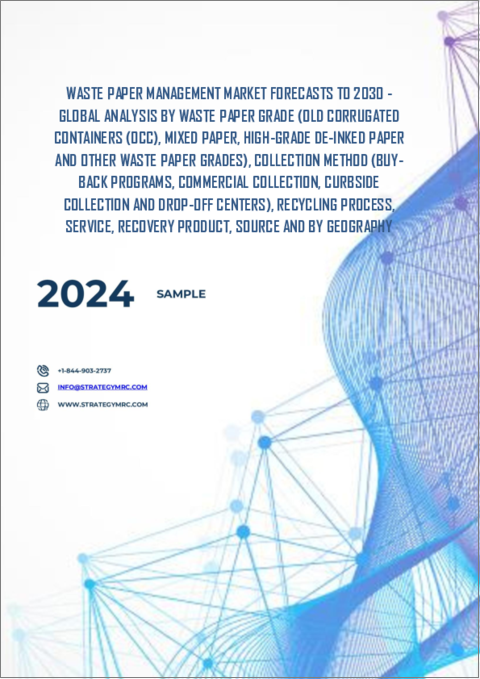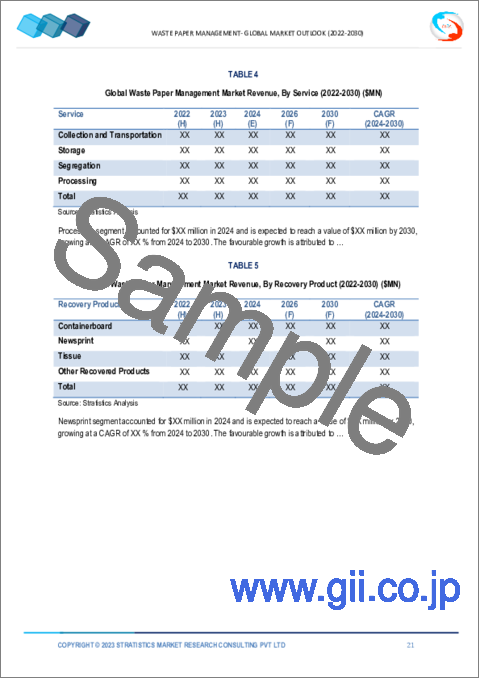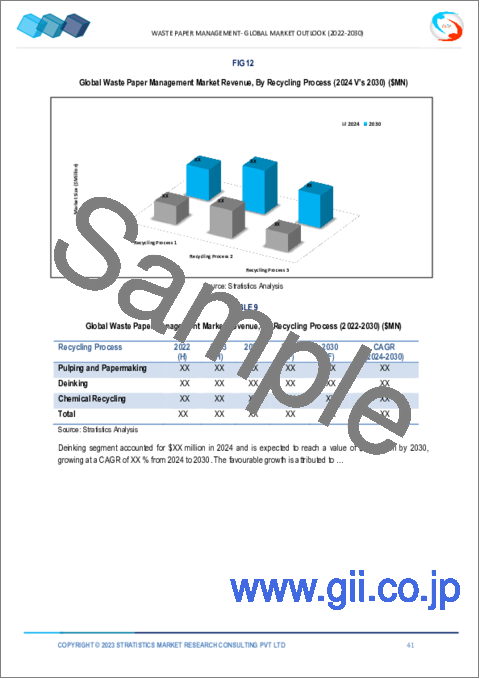|
|
市場調査レポート
商品コード
1489456
古紙管理市場の2030年までの予測: 古紙グレード、回収方法、リサイクルプロセス、サービス、回収製品、排出源、地域別の世界分析Waste Paper Management Market Forecasts to 2030 - Global Analysis By Waste Paper Grade, Collection Method, Recycling Process, Service, Recovery Product, Source and By Geography |
||||||
カスタマイズ可能
|
|||||||
| 古紙管理市場の2030年までの予測: 古紙グレード、回収方法、リサイクルプロセス、サービス、回収製品、排出源、地域別の世界分析 |
|
出版日: 2024年06月06日
発行: Stratistics Market Research Consulting
ページ情報: 英文 200+ Pages
納期: 2~3営業日
|
全表示
- 概要
- 図表
- 目次
Stratistics MRCによると、世界の古紙管理市場は2023年に474億米ドルを占め、予測期間中のCAGRは5.2%で成長し、2030年には677億米ドルに達すると予測されています。
古紙管理は、環境への影響を最小限に抑え、資源効率を最大化するために、使用済み紙材料の収集、処理、リサイクルを含みます。回収、選別、パルプ化、脱インキ、リサイクルなどの活動が含まれ、紙廃棄物の埋立地からの転用、天然資源の保護、温室効果ガス排出量の削減を目的としています。
環境保護庁によると、配布資料、コピー用紙、ノートなどのオフィス用紙製品は、埋立廃棄物の中で最も大きな割合を占めています。オフィス用紙をリサイクルするだけで、木から紙を作るのに必要なエネルギーの33%を節約でき、何千ガロンもの水も節約できます。
再生紙需要の増加
再生紙への需要の高まりは、古紙管理市場の主要な促進要因です。環境への関心が高まるにつれ、再生紙を含む環境に優しい製品を選ぶ消費者や企業が増えています。このような嗜好の変化は、効率的な古紙回収、選別、リサイクルプロセスの必要性に拍車をかけています。再生紙はバージンパルプの需要を減らし、天然資源を保護し、温室効果ガスの排出を削減します。その結果、再生紙需要の高まりは古紙管理市場の成長にプラスの影響を与えています。
インフラの課題
古紙回収・処理のための適切なインフラが整備されていないことが、市場の大きな抑制要因となっています。多くの地域、特に発展途上国では、古紙の分別、収集、運搬のための適切なシステムが欠如しています。そのため、リサイクル可能な古紙の大部分が埋立地に捨てられたり、他の廃棄物に汚染されたりして、リサイクルに適さなくなっています。さらに、リサイクル施設の設置には高額な初期投資が必要であり、高度な技術が必要とされるため、市場成長の課題となっています。
リサイクル技術の革新
選別機構の改善、より効率的なパルプ化工程、より優れた汚染物質除去技術などの革新は、古紙の品質を向上させ、リサイクル率を高めることができます。さらに、包装や建材など古紙の新たな用途開拓は、市場成長の新たな道を開く可能性があります。技術が進歩すれば、従来のリサイクル方法の限界を克服し、古紙管理ソリューションの需要を促進することができます。
古紙の不法投棄
古紙の不法投棄は古紙管理市場に脅威を与えています。古紙が許可されていない場所に投棄されると、環境を汚染するだけでなく、処理に利用できるリサイクル可能な材料の量も減少します。不法投棄は、意識の欠如、不十分な回収インフラ、あるいは廃棄コストを避けたいという願望によって起こりうる。このような行為は、古紙管理業界の努力を台無しにし、環境と健康に害を及ぼす可能性があります。
COVID-19の影響:
COVID-19の流行は古紙管理市場に様々な影響を与えました。施錠中のオフィス、学校、企業の臨時閉鎖は古紙の発生を減少させました。しかし、eコマース活動の急増と使い捨て包装資材の使用の増加は、家庭からの古紙量の増加につながった。また、パンデミックは世界のサプライチェーンを混乱させ、古紙の収集と輸送に影響を与えました。
予測期間中、旧式段ボール(OCC)分野が最大になると予想される
古紙管理市場では、旧段ボール(OCC)分野が最大のシェアを占めると予想されています。eコマースの成長と段ボール包装材の使用の増加が、このセグメントの主な促進要因です。OCCはリサイクル性が高く、新しい段ボール箱やその他の紙製品の生産に高い需要があります。OCCは大量に発生し、リサイクルも容易であるため、古紙管理市場に大きく貢献しています。
ケミカルリサイクル分野は予測期間中に最も高いCAGRが見込まれる
ケミカルリサイクルは、市場で最も高い成長率を示すと予想されます。この革新的なリサイクル方法は、従来の機械的リサイクルでは処理できなかった複雑で汚染された古紙のリサイクルを可能にします。ケミカルリサイクルは高品質な再生紙の製造を可能にし、様々な用途における再生材料の利用に新たな可能性をもたらします。高品位古紙の需要が高まるにつれ、ケミカルリサイクル分野は大きく成長する見込みです。
最大のシェアを持つ地域
古紙管理市場では欧州が最大のシェアを占めると予想されます。同地域は古紙回収とリサイクルのインフラが確立されており、厳しい規制と環境政策に支えられています。欧州連合(EU)の循環型経済構想や廃棄物削減・リサイクル目標が、同地域の古紙管理産業の成長を後押ししています。加えて、欧州における消費者の高い意識と環境に優しい製品への嗜好が、再生紙への旺盛な需要と市場における同地域の優位性に寄与しています。
CAGRが最も高い地域:
アジア太平洋地域は、古紙管理市場において最も高い成長率を示すと予想されます。同地域では人口の急増、都市化、工業化が進み、大量の古紙が発生しています。中国やインドのような国々ではeコマース活動や包装資材の使用が急増しており、OCCやその他の古紙の発生が増加しています。さらに、この地域の政府は、古紙のリサイクルと持続可能な廃棄物管理を促進するための政策やイニシアティブを実施しています。意識の高まりとインフラの改善により、アジア太平洋地域の古紙管理市場は大きく成長する見込みです。
無料のカスタマイズサービス
本レポートをご購読のお客様には、以下の無料カスタマイズオプションのいずれかをご利用いただけます:
- 企業プロファイル
- 追加市場プレイヤーの包括的プロファイリング(3社まで)
- 主要企業のSWOT分析(3社まで)
- 地域セグメンテーション
- 顧客の関心に応じた主要国の市場推計・予測・CAGR(注:フィージビリティチェックによる)
- 競合ベンチマーキング
- 製品ポートフォリオ、地理的プレゼンス、戦略的提携に基づく主要企業のベンチマーキング
目次
第1章 エグゼクティブサマリー
第2章 序文
- 概要
- ステークホルダー
- 調査範囲
- 調査手法
- データマイニング
- データ分析
- データ検証
- 調査アプローチ
- 調査情報源
- 1次調査情報源
- 2次調査情報源
- 前提条件
第3章 市場動向分析
- 促進要因
- 抑制要因
- 機会
- 脅威
- 新興市場
- COVID-19の影響
第4章 ポーターのファイブフォース分析
- 供給企業の交渉力
- 買い手の交渉力
- 代替品の脅威
- 新規参入業者の脅威
- 競争企業間の敵対関係
第5章 世界の古紙管理市場:廃紙グレード別
- 古い段ボール容器(OCC)
- ミックスペーパー
- 高級脱インク紙
- その他の古紙グレード
第6章 世界の古紙管理市場:収集方法別
- 買い戻しプログラム
- 商業コレクション
- カーブサイドコレクション
- ドロップオフセンター
第7章 世界の古紙管理市場:リサイクルプロセス別
- パルプ製造と製紙
- 脱墨
- 化学リサイクル
第8章 世界の古紙管理市場:サービス別
- 収集と輸送
- ストレージ
- 分離
- 処理
第9章 世界の古紙管理市場:回収製品別
- コンテナボード
- 新聞用紙
- ティシュー
- その他の回収製品
第10章 世界の古紙管理市場:排出源別
- 住宅
- 産業
- 商業
- 公共機関
第11章 世界の古紙管理市場:地域別
- 北米
- 米国
- カナダ
- メキシコ
- 欧州
- ドイツ
- 英国
- イタリア
- フランス
- スペイン
- その他欧州
- アジア太平洋地域
- 日本
- 中国
- インド
- オーストラリア
- ニュージーランド
- 韓国
- その他アジア太平洋地域
- 南米
- アルゼンチン
- ブラジル
- チリ
- その他南米
- 中東・アフリカ
- サウジアラビア
- アラブ首長国連邦
- カタール
- 南アフリカ
- その他中東とアフリカ
第12章 主な発展
- 契約、パートナーシップ、コラボレーション、合弁事業
- 買収と合併
- 新製品発売
- 事業拡大
- その他の主要戦略
第13章 企業プロファイリング
- Cascades Inc.
- DS Smith plc
- Georgia-Pacific LLC
- International Paper Company
- Mondi Group
- Nippon Paper Industries Co., Ltd.
- Pratt Industries, Inc.
- Republic Services, Inc.
- Resolute Forest Products
- Rumpke Consolidated Companies, Inc.
- SAICA Group
- Smurfit Kappa Group
- Sonoco Products Company
- SUEZ Group
- UPM-Kymmene Corporation
- Veolia Environnement S.A.
- Waste Management, Inc.
- WestRock Company
List of Tables
- Table 1 Global Waste Paper Management Market Outlook, By Region (2021-2030) ($MN)
- Table 2 Global Waste Paper Management Market Outlook, By Waste Paper Grade (2021-2030) ($MN)
- Table 3 Global Waste Paper Management Market Outlook, By Old Corrugated Containers (OCC) (2021-2030) ($MN)
- Table 4 Global Waste Paper Management Market Outlook, By Mixed Paper (2021-2030) ($MN)
- Table 5 Global Waste Paper Management Market Outlook, By High-Grade De-Inked Paper (2021-2030) ($MN)
- Table 6 Global Waste Paper Management Market Outlook, By Other Waste Paper Grades (2021-2030) ($MN)
- Table 7 Global Waste Paper Management Market Outlook, By Collection Method (2021-2030) ($MN)
- Table 8 Global Waste Paper Management Market Outlook, By Buy-Back Programs (2021-2030) ($MN)
- Table 9 Global Waste Paper Management Market Outlook, By Commercial Collection (2021-2030) ($MN)
- Table 10 Global Waste Paper Management Market Outlook, By Curbside Collection (2021-2030) ($MN)
- Table 11 Global Waste Paper Management Market Outlook, By Drop-Off Centers (2021-2030) ($MN)
- Table 12 Global Waste Paper Management Market Outlook, By Recycling Process (2021-2030) ($MN)
- Table 13 Global Waste Paper Management Market Outlook, By Pulping and Papermaking (2021-2030) ($MN)
- Table 14 Global Waste Paper Management Market Outlook, By Deinking (2021-2030) ($MN)
- Table 15 Global Waste Paper Management Market Outlook, By Chemical Recycling (2021-2030) ($MN)
- Table 16 Global Waste Paper Management Market Outlook, By Service (2021-2030) ($MN)
- Table 17 Global Waste Paper Management Market Outlook, By Collection and Transportation (2021-2030) ($MN)
- Table 18 Global Waste Paper Management Market Outlook, By Storage (2021-2030) ($MN)
- Table 19 Global Waste Paper Management Market Outlook, By Segregation (2021-2030) ($MN)
- Table 20 Global Waste Paper Management Market Outlook, By Processing (2021-2030) ($MN)
- Table 21 Global Waste Paper Management Market Outlook, By Recovery Product (2021-2030) ($MN)
- Table 22 Global Waste Paper Management Market Outlook, By Containerboard (2021-2030) ($MN)
- Table 23 Global Waste Paper Management Market Outlook, By Newsprint (2021-2030) ($MN)
- Table 24 Global Waste Paper Management Market Outlook, By Tissue (2021-2030) ($MN)
- Table 25 Global Waste Paper Management Market Outlook, By Other Recovered Products (2021-2030) ($MN)
- Table 26 Global Waste Paper Management Market Outlook, By Source (2021-2030) ($MN)
- Table 27 Global Waste Paper Management Market Outlook, By Residential (2021-2030) ($MN)
- Table 28 Global Waste Paper Management Market Outlook, By Industrial (2021-2030) ($MN)
- Table 29 Global Waste Paper Management Market Outlook, By Commercial (2021-2030) ($MN)
- Table 30 Global Waste Paper Management Market Outlook, By Institutional (2021-2030) ($MN)
Note: Tables for North America, Europe, APAC, South America, and Middle East & Africa Regions are also represented in the same manner as above.
According to Stratistics MRC, the Global Waste Paper Management Market is accounted for $47.4 billion in 2023 and is expected to reach $67.7 billion by 2030 growing at a CAGR of 5.2% during the forecast period. Waste paper management involves the collection, processing, and recycling of used paper materials to minimize environmental impact and maximize resource efficiency. It includes activities such as collection, sorting, pulping, de-inking, and recycling aimed at diverting paper waste from landfills, conserving natural resources, and reducing greenhouse gas emissions.
According to the Environmental Protection Agency, office paper products such as handouts, copy paper, and notebooks make up the largest percentage of landfill waste. Recycling office paper alone can save 33% of the energy needed to make paper from trees, as well as thousands of gallons of water.
Market Dynamics:
Driver:
Rising demand for recycled paper
The increasing demand for recycled paper is a key driver for the waste paper management market. As environmental concerns grow, more consumers and businesses are opting for eco-friendly products, including recycled paper. This shift in preference is fueling the need for efficient waste paper collection, sorting, and recycling processes. Recycled paper reduces the demand for virgin pulp, conserves natural resources, and lowers greenhouse gas emissions. As a result, the rising demand for recycled paper is positively influencing the growth of the waste paper management market.
Restraint:
Infrastructure challenges
The lack of adequate infrastructure for waste paper collection and processing is a significant restraint for the market. Many regions, particularly in developing countries, lack proper systems for segregating, collecting, and transporting waste paper. This leads to a large portion of recyclable paper ending up in landfills or being contaminated with other waste, making it unsuitable for recycling. Moreover, the high initial investment required to set up recycling facilities and the need for advanced technologies pose challenges for market growth.
Opportunity:
Innovation in recycling technologies
Innovations such as improved sorting mechanisms, more efficient pulping processes, and better contaminant removal techniques can enhance the quality of recycled paper and increase recycling rates. Furthermore, the development of new applications for recycled paper, such as in packaging and construction materials, can open up new avenues for market growth. As technology progresses, it can help overcome the limitations of traditional recycling methods and drive the demand for waste paper management solutions.
Threat:
Illegal dumping of waste paper
Illegal dumping of waste paper poses a threat to the waste paper management market. When waste paper is dumped in unauthorized locations, it not only pollutes the environment but also reduces the amount of recyclable material available for processing. Illegal dumping can occur due to a lack of awareness, insufficient collection infrastructure, or the desire to avoid disposal costs. This practice undermines the efforts of the waste paper management industry and can lead to environmental and health hazards.
Covid-19 Impact:
The COVID-19 pandemic has had a mixed impact on the waste paper management market. The temporary closure of offices, schools, and businesses during lockdowns reduced the generation of waste paper. However, the surge in e-commerce activities and the increased use of disposable packaging materials led to a higher volume of waste paper from households. The pandemic also disrupted global supply chains, affecting the collection and transportation of waste paper.
The old corrugated containers (OCC) segment is expected to be the largest during the forecast period
The old corrugated containers (OCC) segment is expected to hold the largest share in the waste paper management market. The growth of e-commerce and the increasing use of corrugated packaging materials are the primary drivers for this segment. OCC is highly recyclable and is in high demand for the production of new corrugated boxes and other paper products. The large volume of OCC generated, coupled with its easy recyclability, makes it a significant contributor to the waste paper management market.
The chemical recycling segment is expected to have the highest CAGR during the forecast period
Chemical recycling is expected to witness the highest growth rate in the market. This innovative recycling method enables the recycling of complex and contaminated waste paper that cannot be processed through traditional mechanical recycling. Chemical recycling allows for the production of high-quality recycled paper and opens up new possibilities for the use of recycled materials in various applications. As the demand for high-grade recycled paper grows, the chemical recycling segment is poised for significant growth.
Region with largest share:
Europe is expected to hold the largest share in the waste paper management market. The region has a well-established waste paper collection and recycling infrastructure, supported by stringent regulations and environmental policies. The European Union's circular economy initiatives and targets for waste reduction and recycling have driven the growth of the waste paper management industry in the region. Additionally, the high consumer awareness and preference for eco-friendly products in Europe contribute to the strong demand for recycled paper and the dominance of the region in the market.
Region with highest CAGR:
The Asia Pacific region is expected to exhibit the highest growth rate in the waste paper management market. The region's rapidly growing population, urbanization, and industrialization are generating substantial amounts of waste paper. Countries like China and India are witnessing a surge in e-commerce activities and the use of packaging materials, leading to an increased generation of OCC and other waste paper. Moreover, governments in the region are implementing policies and initiatives to promote waste paper recycling and sustainable waste management practices. As awareness grows and infrastructure improves, the Asia Pacific region is poised for significant growth in the waste paper management market.
Key players in the market
Some of the key players in Waste Paper Management Market include Cascades Inc., DS Smith plc, Georgia-Pacific LLC, International Paper Company, Mondi Group, Nippon Paper Industries Co., Ltd., Pratt Industries, Inc., Republic Services, Inc., Resolute Forest Products, Rumpke Consolidated Companies, Inc., SAICA Group, Smurfit Kappa Group, Sonoco Products Company, SUEZ Group, UPM-Kymmene Corporation, Veolia Environnement S.A., Waste Management, Inc. and WestRock Company.
Key Developments:
In November 2023, The national Australian government and Queensland state government have joined forces with Brisbane-based company AusWaste Recycling to construct a waste paper recycling plant in Brendale, Queensland, Australia. With an investment of $137m, the Australian Recycled Pulp and Paper Project will be built in South East Queensland. The development has received $40m in combined funding from both governments via the Recycling Modernisation Fund.
In April 2021, North Pacific Paper Company is pushing further into the recycled paper market, adding a new drum pulper that will support an existing 400 mill jobs and produce recycled packaging papers from waste material previously sent to China.
Waste Paper Grades Covered:
- Old Corrugated Containers (OCC)
- Mixed Paper
- High-Grade De-Inked Paper
- Other Waste Paper Grades
Collection Methods Covered:
- Buy-Back Programs
- Commercial Collection
- Curbside Collection
- Drop-Off Centers
Recycling Process Covered:
- Pulping and Papermaking
- Deinking
- Chemical Recycling
Services Covered:
- Collection and Transportation
- Storage
- Segregation
- Processing
Recovered Products Covered:
- Containerboard
- Newsprint
- Tissue
- Other Recovered Products
Sources Covered:
- Residential
- Industrial
- Commercial
- Institutional
Regions Covered:
- North America
- US
- Canada
- Mexico
- Europe
- Germany
- UK
- Italy
- France
- Spain
- Rest of Europe
- Asia Pacific
- Japan
- China
- India
- Australia
- New Zealand
- South Korea
- Rest of Asia Pacific
- South America
- Argentina
- Brazil
- Chile
- Rest of South America
- Middle East & Africa
- Saudi Arabia
- UAE
- Qatar
- South Africa
- Rest of Middle East & Africa
What our report offers:
- Market share assessments for the regional and country-level segments
- Strategic recommendations for the new entrants
- Covers Market data for the years 2021, 2022, 2023, 2026, and 2030
- Market Trends (Drivers, Constraints, Opportunities, Threats, Challenges, Investment Opportunities, and recommendations)
- Strategic recommendations in key business segments based on the market estimations
- Competitive landscaping mapping the key common trends
- Company profiling with detailed strategies, financials, and recent developments
- Supply chain trends mapping the latest technological advancements
Free Customization Offerings:
All the customers of this report will be entitled to receive one of the following free customization options:
- Company Profiling
- Comprehensive profiling of additional market players (up to 3)
- SWOT Analysis of key players (up to 3)
- Regional Segmentation
- Market estimations, Forecasts and CAGR of any prominent country as per the client's interest (Note: Depends on feasibility check)
- Competitive Benchmarking
- Benchmarking of key players based on product portfolio, geographical presence, and strategic alliances
Table of Contents
1 Executive Summary
2 Preface
- 2.1 Abstract
- 2.2 Stake Holders
- 2.3 Research Scope
- 2.4 Research Methodology
- 2.4.1 Data Mining
- 2.4.2 Data Analysis
- 2.4.3 Data Validation
- 2.4.4 Research Approach
- 2.5 Research Sources
- 2.5.1 Primary Research Sources
- 2.5.2 Secondary Research Sources
- 2.5.3 Assumptions
3 Market Trend Analysis
- 3.1 Introduction
- 3.2 Drivers
- 3.3 Restraints
- 3.4 Opportunities
- 3.5 Threats
- 3.6 Emerging Markets
- 3.7 Impact of Covid-19
4 Porters Five Force Analysis
- 4.1 Bargaining power of suppliers
- 4.2 Bargaining power of buyers
- 4.3 Threat of substitutes
- 4.4 Threat of new entrants
- 4.5 Competitive rivalry
5 Global Waste Paper Management Market, By Waste Paper Grade
- 5.1 Introduction
- 5.2 Old Corrugated Containers (OCC)
- 5.3 Mixed Paper
- 5.4 High-Grade De-Inked Paper
- 5.5 Other Waste Paper Grades
6 Global Waste Paper Management Market, By Collection Method
- 6.1 Introduction
- 6.2 Buy-Back Programs
- 6.3 Commercial Collection
- 6.4 Curbside Collection
- 6.5 Drop-Off Centers
7 Global Waste Paper Management Market, By Recycling Process
- 7.1 Introduction
- 7.2 Pulping and Papermaking
- 7.3 Deinking
- 7.4 Chemical Recycling
8 Global Waste Paper Management Market, By Service
- 8.1 Introduction
- 8.2 Collection and Transportation
- 8.3 Storage
- 8.4 Segregation
- 8.5 Processing
9 Global Waste Paper Management Market, By Recovery Product
- 9.1 Introduction
- 9.2 Containerboard
- 9.3 Newsprint
- 9.4 Tissue
- 9.5 Other Recovered Products
10 Global Waste Paper Management Market, By Source
- 10.1 Introduction
- 10.2 Residential
- 10.3 Industrial
- 10.4 Commercial
- 10.5 Institutional
11 Global Waste Paper Management Market, By Geography
- 11.1 Introduction
- 11.2 North America
- 11.2.1 US
- 11.2.2 Canada
- 11.2.3 Mexico
- 11.3 Europe
- 11.3.1 Germany
- 11.3.2 UK
- 11.3.3 Italy
- 11.3.4 France
- 11.3.5 Spain
- 11.3.6 Rest of Europe
- 11.4 Asia Pacific
- 11.4.1 Japan
- 11.4.2 China
- 11.4.3 India
- 11.4.4 Australia
- 11.4.5 New Zealand
- 11.4.6 South Korea
- 11.4.7 Rest of Asia Pacific
- 11.5 South America
- 11.5.1 Argentina
- 11.5.2 Brazil
- 11.5.3 Chile
- 11.5.4 Rest of South America
- 11.6 Middle East & Africa
- 11.6.1 Saudi Arabia
- 11.6.2 UAE
- 11.6.3 Qatar
- 11.6.4 South Africa
- 11.6.5 Rest of Middle East & Africa
12 Key Developments
- 12.1 Agreements, Partnerships, Collaborations and Joint Ventures
- 12.2 Acquisitions & Mergers
- 12.3 New Product Launch
- 12.4 Expansions
- 12.5 Other Key Strategies
13 Company Profiling
- 13.1 Cascades Inc.
- 13.2 DS Smith plc
- 13.3 Georgia-Pacific LLC
- 13.4 International Paper Company
- 13.5 Mondi Group
- 13.6 Nippon Paper Industries Co., Ltd.
- 13.7 Pratt Industries, Inc.
- 13.8 Republic Services, Inc.
- 13.9 Resolute Forest Products
- 13.10 Rumpke Consolidated Companies, Inc.
- 13.11 SAICA Group
- 13.12 Smurfit Kappa Group
- 13.13 Sonoco Products Company
- 13.14 SUEZ Group
- 13.15 UPM-Kymmene Corporation
- 13.16 Veolia Environnement S.A.
- 13.17 Waste Management, Inc.
- 13.18 WestRock Company





